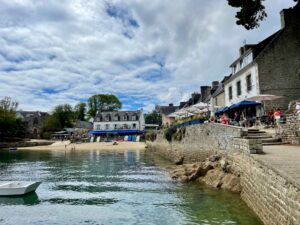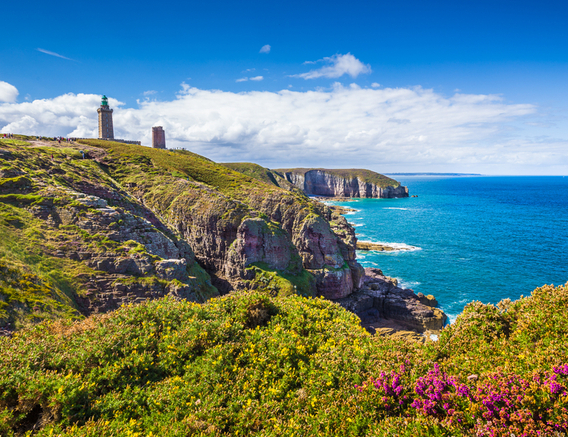Brittany’s stunning Atlantic beaches, historic towns and rustic lifestyle are what draws typical house-hunters there. And while its temperate climate was once a deal-breaker for serious sun-worshippers, even that is changing.
Here are six reasons France’s fourth largest tourist region may be your ticket to la belle vie!
Coast, countryside and culture!
Brittany blends breath-taking coastline and traditional understated resorts with ancient towns and lush wooded countryside. Its most westerly department, Finistère, has its wildest, most mesmerizing beaches, particularly around the Crozon peninsula, and is home to the important maritime city of Brest, cultural gem Quimper and popular Bay of Morlaix. Côtes d’Armor covers the majority of Brittany’s northern coastline, with popular coastal areas centred around the charming towns of Lannion, St-Brieuc and Dinan.
On the central southern coast is Morbihan, were favourite seaside areas include Vannes, Carnac and Quiberon, and inland around Josselin. Not forgetting Ille-et-Vilaine, home to regional capital Rennes, famed for its half-timbered houses, historic port city Saint-Malo and inland riverside town of Redon.
Plane, train or automobile?
Brits are spoilt for choice when it comes to travelling to Brittany. Driving is a popular option, thanks to the Eurotunnel and choice of ferry routes along France’s north-west coast. Allow 7-8 hours for a typical drive time from Calais to Finistère, slightly less for more easterly areas. Flying options from various UK airports include routes to Brest, Rennes, Nantes or Dinard. Meanwhile, Rennes, Brest and Quimper all have a direct TGV rail service from Paris, which is reachable via the Eurostar from London.

Silver cloud of changing climate
France’s more southerly regions, especially around the Med, historically have been more attractive to house-hunters who value year-round sunshine and long hot summers. Brittany’s cooler, wetter and often windier winters mean it could never compete on that front. But Europe’s changing weather patterns and the increasing occurrence of extreme conditions, including droughts and forest fires, make the region’s steadier temperature climate increasingly attractive. The French have even coined a phrase for sun-seekers swapping hotter less predictable destinations for Brittany, namely ‘migrants climatiques’!
Look at this gorgeous three-bedroom home in a Brittany village, €220,500
Post-pandemic uplift
Much like in less built-up parts of the UK, previously overlooked corners of Brittany have seen a hike in interest from French buyers since the pandemic. Rural communities are in demand with buyers looking to relocate from busy urban areas, now preferring a larger home that offers a healthy outdoors lifestyle and space to work from home. Similarly, second homes for holidays and spells of ‘télétravail’ (homeworking) are helping to boost Brittany’s coastal apartment market. All of this means prices are creeping up but previously sleepy villages are seeing a resurgence of life.
The Cornish-Celtic connection
The local people of Brittany – known as Bretons – have a Celtic heritage linked to the Celts in Britain. As such, Bretons have a distinct cultural identity, which includes their own language, festivals and customs (even their own cola drink!). In the UK, Cornwall retains a deep-rooted connection with Brittany, not only due to the two regions’ Celtic ancestry but also their similar coastal landscapes that have helped shape their culture.
No surprise then that the south-western corner of Finistère is still referred to as La Côte de Cornouaille’, having the strongest association with Cornwall. This area is especially picturesque and includes Quimper, a small medieval city on the Odet river famous for pottery.
A few kilometres downstream is the family resort of Bénodet which sits on the estuary opposite the small riverfront village of Sainte-Marine, the two connected by a small ferry boat and bridge. Bénodet has a marina, quayside with ferries to Quimper and the Glénan Islands, selection of beaches and lagoon. Fousnant and La Forêt-Fousnant just east are two pretty villages around a bay and with one of Brittany’s largest leisure marinas. Then there is charming Concarneau, a seaside town with a historic fortified island within its working fishing harbour and beautiful beaches.
Discover a two-bedroom coastal property in Brittany

Gastronomy in Brittany
Brittany is the crêpe capital of France. It’s also serious cider country, with a carafe of local brew still the tipple of choice in traditional crêperies. But there’s so much more to its gastronomy. The freshly landed fish and seafood is world-class, local dairy and baked artisan products, including biscuits, are in abundance. Besides cider, there is a surging craft beer scene and in true Celtic spirit Brittany produces whisky, as well as gin, numerous liqueurs and even wine.
